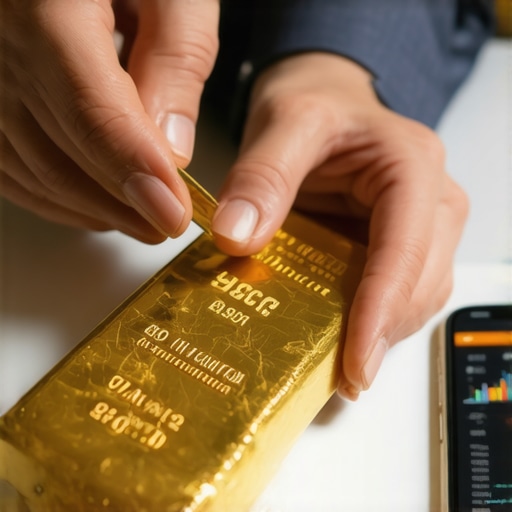Understanding Gold Investment: Debunking Myths for New Investors
Investing in gold has long been considered a safe haven for investors, but it’s essential for beginners to navigate the landscape carefully. Many myths surround gold investing, often leading to confusion and hesitation. In this article, we will address these common misconceptions to help you make informed decisions.
The Reality of Gold Investments
One prevalent myth is that gold investments are only for the wealthy. In reality, gold can be accessible to anyone, regardless of financial status. There are various ways to invest in gold, such as gold coins, bullion bars, gold ETFs, and even mutual funds. Each option has distinct advantages and allows for varying levels of investment.
Gold is Always a Safe Investment
Another misconception is that gold is a foolproof investment that always generates profits. While gold has historically been a stable asset, it does experience market fluctuations just like any other investment. Understanding these market dynamics is crucial for new investors. For example, economic downturns may increase gold demand, but other factors like currency strength and interest rates can also impact its price.
Physical Gold vs. Digital Gold: Making the Right Choice
A common question among beginners is whether to invest in physical gold or gold-backed securities like ETFs. Physical gold offers tangible value, but it also comes with storage and insurance costs. On the other hand, gold ETFs can be more convenient and cost-effective, providing exposure to gold prices without the need for physical ownership. To learn more about this comparison, check out this article.
Gold Investment is Complicated
Many newcomers believe that investing in gold is a complex venture. However, with the right resources and information, you can simplify the process significantly. A good starting point is to educate yourself on the basics of gold investing, which can be achieved through guides like Investing in Gold for Beginners. Understanding the key principles will empower you to make wise investment choices.
Timing the Market
Another myth that plagues new investors is the belief that they need to time the market perfectly to succeed in gold investment. While market timing can enhance returns, it’s not always feasible, especially for beginners. A more effective strategy is to adopt a long-term perspective and invest consistently over time. This approach helps mitigate risks associated with market volatility.
Conclusion: Empowering Your Gold Investment Journey
By debunking these common myths, potential investors can approach gold investment with greater confidence and clarity. Whether you are considering physical gold or exploring ETFs, understanding the realities of gold investing will put you on the path to success. Remember, informed decisions lead to better outcomes in your investment journey.
Exploring the Benefits of Different Gold Investment Options
As you embark on your gold investment journey, understanding the various investment options available can greatly impact your success. From physical gold to digital alternatives, each choice offers unique advantages. For instance, physical gold is often perceived as a safe asset during economic uncertainty, while gold ETFs provide a more liquid alternative. Evaluating these options helps align your investment strategy with your financial goals.
Gold Coins and Bullion Bars: Tangibility and Value
Investing in gold coins and bullion bars is a popular choice among investors who seek tangible assets. These forms of gold not only retain intrinsic value but also carry numismatic appeal. Understanding the factors that influence their prices, such as rarity and market demand, can enhance your investment strategy.
Gold ETFs: A Convenient Entry Point for Investors
Gold exchange-traded funds (ETFs) have gained immense popularity due to their convenience. They allow investors to gain exposure to gold prices without the complexities of physical ownership. For beginners, this can be an excellent way to diversify your portfolio. Learn more about the pros and cons of gold ETFs in the article on choosing between gold ETFs and mutual funds.
Factors Influencing Gold Prices: What Every Investor Should Know
Understanding the dynamics of gold prices is crucial for making informed investment decisions. Several factors can influence the market, including macroeconomic indicators, geopolitical events, and shifts in demand. Keeping abreast of these trends allows you to anticipate market movements and adjust your investment strategy accordingly.
Economic Indicators and Gold Demand
Economic conditions play a significant role in gold demand. During times of inflation or currency devaluation, investors flock to gold as a means of preserving wealth. Monitoring economic indicators can provide insights into potential price movements. For a deeper understanding of how these factors interact, consider reading our comprehensive analysis on gold market dynamics.
The Role of Geopolitical Events
Geopolitical tensions can also have a significant impact on gold prices. Crises or conflicts often lead to increased demand for gold as a safe haven asset. Staying informed about global events and their potential implications for gold can provide a strategic advantage in your investment decisions.
Long-Term Strategies for Gold Investing
As a new investor, adopting a long-term perspective is essential for success in gold investment. Rather than attempting to time the market, focus on building a diversified portfolio that includes various gold assets. This approach not only mitigates risk but also positions you to benefit from long-term price appreciation.
Dollar-Cost Averaging: A Practical Investment Technique
One effective strategy for investing in gold is dollar-cost averaging. This technique involves investing a fixed amount of money at regular intervals, regardless of market conditions. By spreading out your investments, you can reduce the impact of volatility and take advantage of lower prices over time.
Educating Yourself: The Key to Successful Gold Investment
Continuous education is vital for navigating the complexities of gold investing. Resources such as guides for beginners and market analysis reports can empower you with the knowledge necessary to make informed decisions. As you learn and adapt, your confidence in investing will grow.
Understanding the Risks of Gold Investment: A Balanced Perspective
While gold is often considered a safe haven, it is essential for investors to recognize the inherent risks associated with investing in this precious metal. Market fluctuations, geopolitical uncertainties, and changes in economic policies can all impact gold prices. To navigate these risks effectively, familiarize yourself with the key considerations for gold investment that can help you make informed decisions.
Market Volatility: Anticipating Price Fluctuations
Gold prices can experience significant volatility due to a variety of factors, including changes in investor sentiment and broader market trends. Understanding these fluctuations allows you to anticipate potential downturns and make strategic decisions. For instance, during periods of economic instability, gold often sees a surge in demand, which can drive prices higher. Staying updated on market analysis can provide insights into when to buy or sell your gold investments.
Investment Diversification: Mitigating Risks
One of the best strategies to mitigate risks in gold investment is diversification. By spreading your investments across different asset classes—such as stocks, bonds, and real estate—you reduce the overall risk exposure. When investing in gold, consider blending physical gold with other forms like ETFs or mutual funds. This balanced approach helps safeguard your portfolio against market fluctuations.
Exploring Gold Investment Strategies: Maximizing Returns
To maximize returns from gold investments, it’s crucial to adopt effective strategies tailored to market conditions. Whether you are a seasoned investor or just starting, understanding various strategies can enhance your investment outcomes.
Short-Term vs. Long-Term Investment Strategies
When investing in gold, you can choose between short-term trading or long-term holding strategies. Short-term investors may take advantage of price swings for quick profits, while long-term investors often focus on the overall growth potential of gold over time. Each strategy has its merits, and your choice should align with your financial goals and risk tolerance.
Utilizing Gold ETFs for Strategic Exposure
Gold ETFs are an excellent way to gain exposure to gold without the need for physical storage. These funds track the price of gold and can be bought or sold like stocks. For those looking to diversify their portfolios with minimal hassle, gold ETFs present a convenient option. To explore the differences between gold ETFs and mutual funds, check out our guide on choosing the right path.
Future Trends in Gold Investment: What to Watch For
As the global economy evolves, so do the trends in gold investment. Being aware of these trends can help you stay ahead and make proactive investment decisions.
Emerging Markets and Increasing Demand
Emerging markets are showing a rising demand for gold, driven by increasing wealth and economic growth. Countries like China and India are significant consumers of gold, often using it as a means of wealth preservation. Understanding the dynamics of these markets can provide valuable insights into future gold demand and potential price movements.
Technological Innovations in Gold Trading
The advent of technology has transformed the way investors buy and sell gold. From online trading platforms to blockchain technology, innovations are making gold investment more accessible. Keeping abreast of these changes can provide you with tools that enhance your trading efficiency and investment strategies.
Understanding the Evolving Gold Market: Key Insights for 2025
As global financial landscapes shift, the gold market continues to present unique opportunities and challenges for investors. Staying informed about the evolving dynamics is essential for making sound investment decisions. In this section, we will explore critical factors influencing the future of gold investments.
Geopolitical Factors: The Role of Global Events
Geopolitical events significantly affect gold prices as investors often turn to gold as a safe haven during times of uncertainty. From tensions between nations to economic sanctions, understanding these geopolitical influences can provide insights into potential price movements. For example, escalating conflicts in major gold-consuming countries can lead to increased demand, thereby elevating prices. Keeping abreast of current events and their potential implications on the gold market is vital for strategic investment planning.
Central Bank Policies: Impact on Gold Demand
Central banks play a crucial role in shaping the gold market through their monetary policies. When central banks adopt accommodative policies, such as low-interest rates or quantitative easing, the demand for gold typically rises. Investors often seek gold to hedge against inflation and currency devaluation. Monitoring central bank actions can provide valuable signals regarding future gold demand. To gain further insights, consider exploring our analysis on key data every investor needs.
Investment Strategies: Adapting to Market Changes
In a constantly changing market, adapting your investment strategies is crucial for maximizing returns. Here, we delve into effective strategies tailored for the evolving gold landscape.
Dollar-Cost Averaging: A Steady Approach
Implementing a dollar-cost averaging strategy can be beneficial for gold investors. This approach involves consistently investing a fixed amount in gold over time, regardless of market fluctuations. By spreading out purchases, investors can mitigate the impact of volatility and potentially acquire gold at a lower average cost. This strategy is particularly useful for long-term investors looking to build a steady gold portfolio.
Utilizing Technology for Enhanced Trading
Advancements in technology have transformed gold trading, providing investors with more tools and platforms to execute trades efficiently. From mobile trading apps to algorithmic trading strategies, leveraging technology can enhance your trading capabilities. By utilizing these tools, investors can access real-time market data, set alerts, and automate their trading strategies. To explore more about effective trading techniques, check out our post on effective trading techniques for maximum ROI.
Final Thoughts: Preparing for Tomorrow’s Gold Market
As we look ahead to 2025, understanding the trends and strategies discussed can significantly impact your gold investment outcomes. Whether it’s staying informed about geopolitical factors, adapting investment strategies, or leveraging technology, being proactive is essential. By doing so, you can position yourself to take advantage of the unique opportunities that the gold market presents.
Frequently Asked Questions About Gold Investments
As we continue to explore the intricacies of gold investments, it’s essential to address common queries that potential investors often have. In this FAQ section, we provide clear, concise answers to help you navigate the gold market effectively.
What are the main factors influencing gold prices?
The primary factors influencing gold prices include geopolitical tensions, inflation rates, interest rates set by central banks, and overall market demand. Understanding these elements can help investors anticipate price movements.
Is investing in gold a safe investment?
Gold is often considered a safe-haven asset, especially during economic downturns. However, like any investment, it carries risks. Diversifying your portfolio with gold can provide a hedge against market volatility.
How can I invest in gold?
Investors can buy physical gold, such as coins and bars, or invest in gold-related financial instruments, including ETFs, mutual funds, and mining stocks. Each option has its advantages and risks, so consider your investment goals before proceeding.
What is the best way to store physical gold?
Storing physical gold securely is crucial. Investors typically opt for safe deposit boxes at banks or specialized storage facilities. Home storage can also be an option, but it comes with increased risks of theft.
How does inflation affect gold prices?
Inflation tends to drive gold prices higher, as investors seek to protect their purchasing power. When inflation rises, the value of currency decreases, making gold an attractive investment to hedge against loss.
Are gold investments suitable for long-term holding?
Yes, gold can be a suitable long-term investment. Historically, it has maintained its value over time and can provide a buffer during economic instability. Long-term investors may benefit from price appreciation and portfolio diversification.
Can I use gold as collateral for loans?
Yes, many lenders accept gold as collateral for loans. The amount you can borrow typically depends on the current market value of the gold and the lender’s policies.
How often should I review my gold investments?
Regular reviews of your gold investments are advisable, especially in response to market changes, economic conditions, and personal financial goals. A semi-annual or annual review can help ensure your investment strategy remains aligned with your objectives.
What are the tax implications of selling gold?
In many jurisdictions, profits from selling gold are subject to capital gains tax. It’s essential to consult with a tax professional to understand the specific tax rules in your area before selling gold.
Where can I find reliable information about gold investments?
Reliable information about gold investments can be found through financial news websites, investment blogs, and scholarly articles. Trusted sources include government financial institutions, financial advisors, and established investment firms.
Authority Resources for Gold Investment Insights
For those seeking in-depth knowledge and expert opinions on gold investments, consider these authoritative resources:
- World Gold Council – Offers comprehensive insights on gold demand and market trends.
- Investopedia: Gold Investment Guide – A thorough guide covering various aspects of gold investments.
- Kitco News – Provides real-time gold prices, news, and market analysis.
- BullionVault – An online marketplace for buying and selling physical gold.
- Federal Reserve – Offers insights into monetary policy and its impact on gold prices.
Conclusion: Embracing the Future of Gold Investments
As we have explored throughout this article, the gold market presents a myriad of opportunities and challenges for investors. By understanding the factors that influence gold prices, employing strategic investment approaches, and utilizing authoritative resources, you can position yourself for success in the evolving landscape of gold investments. Whether you are a seasoned investor or just starting, staying informed and adaptable will be key to navigating the future of gold in 2025 and beyond.











Having started my own journey into gold investing recently, I found this article to be incredibly insightful! One of the most important things I learned is that gold isn’t just for the affluent; with options like gold ETFs, it’s possible to access the market even with limited funds. The point about market fluctuations really resonated with me as well. I initially thought gold was immune to risks, but understanding that it can drop in value just like stocks has made me more cautious and thoughtful about timing my purchases.
Dollar-cost averaging has become a strategy I’m considering. It seems like a smart way to buffer against volatility. I’ve noticed prices can swing quite a bit over short periods, so investing a consistent amount periodically might help me balance out those dips. I also appreciate the emphasis on ongoing education, as I’ve been diving into articles and seminars to build my knowledge base. Looking forward to implementing these strategies and keeping a close eye on economic indicators as I proceed!